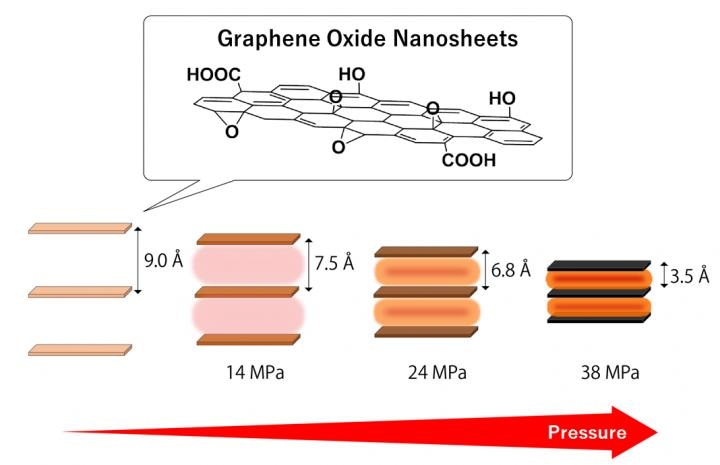Oct 3 2017
Graphene is single-atom-thick sheet of carbon that has gained global attention as an innovative material. A team of Scientists from Kumamoto University, Japan, has found out that we can generate pressure by simply mounting graphene oxide nanosheets one over the other, where graphene oxide is highly identical to graphene.
The Researchers also discovered that when the interlayer distance is reduced by means of heat treatment, the pressure is increased. It is a novel technique for exerting high pressure without the need for extensive amounts of energy.
 Graphene oxide nanosheets are subjected to very high pressure when the interlayer distance is shortened by heat treatment. The thickness of one nanosheet is around 1 nm. (1 Å = 0.1 nm = 0.0000001 mm). CREDIT: Assistant Professor Ryo Ohtani.
Graphene oxide nanosheets are subjected to very high pressure when the interlayer distance is shortened by heat treatment. The thickness of one nanosheet is around 1 nm. (1 Å = 0.1 nm = 0.0000001 mm). CREDIT: Assistant Professor Ryo Ohtani.
Andre Geim and Konstantin Novoselov were awarded with the 2010 Nobel Prize in Physics for cutting-edge graphene experiments. Apart from being extremely thin, flexible and strong, graphene has higher electrical conductivity. A number of oxygen functional groups are present at the front and back of graphene in oxidized graphene nanosheets. Moreover, earlier studies have demonstrated that heat treatment of multiple layers of oxidized graphene nanosheets leads to shrinking of the interlayer distance because the oxygen functional groups are removed.
Consequently, the Kumamoto University Scientists concluded that when the interlayer distance between the graphene oxide nanosheets is reduced, it can be used as a compressor exerting pressure to a substance positioned in between the sheets. For measuring the pressure between the nanosheets, the Researchers used molecular materials with the ability to alter the electrical state of metal ions as a result of pressure (spin crossover phenomenon). They sandwiched the material and measured the spin crossover phenomenon between the graphene oxide nanosheets in order to detect the electrical state change of iron nanoparticles.
Reduction in the interlayer distance leads to increase in the pressure between the layers, that is, the value of pressure can be adjusted by adjusting the temperature of heat treatment. The maximum pressure measured by the Scientists was 38 x 106 Pa, that is, 101,300 Pa at atmospheric pressure, or about 375 atm. Furthermore, they also discovered that there is no increase in pressure if the nanosheets are not mounted over each other perfectly.
There are several examples of special materials that cause compression by just sandwiching or wrapping, similar to our results here. But, as far as we know, this graphene nanosheet is the first example in the world with the ability to adjust applied pressure by simply changing the heat treatment temperature. We expect that this ‘nano-compressor’ will lead to new developments from fields such as material chemistry or physics. Particularly since this technique produces high pressures that normally cannot be obtained without adding a large amount of energy.
Assistant Professor Ryo Ohtani, Kumamoto University, who was the Lead Author of the study